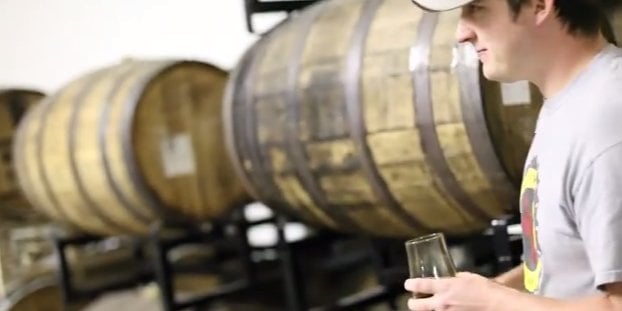
Picture this: A brewery has 5,000 barrels of a limited-edition brew aging in wine barrels. They’ve invested in the barrels, the beer and the design for the labels, and they expect to do brisk sales of this beer over the holiday season.
On the beer’s third month of barrel-aging, a new forklift driver loses control of his vehicle and rams into a stack of barrels. Like an elaborate domino scheme, thousands of barrels are rattled off their racks and are damaged; most of the product is lost.
So, what happens next? How can a brewer recoup the loss when barrel-aging a beer goes awry?
In this article, we examine the expenses and risks associated with barrel aging beer, particularly what can go wrong while the beer is aging and what brewers can do to make sure their investment is protected.
A trend has been brewing
Barrel-aged beer has grown tremendously in popularity over the last 15 years across the country. While there does not seem to be a clear line in history pointing to the first barrel-aged beer, some attribute this honor to Chicago-based Goose Island and its 1992 Bourbon County Stout. Meanwhile, others like the Madfermentationist claim that the trend was started by Belgium Lambic and Flanders Red producers who used wood barrels to age sour ales and other beers.
Like many new beer varieties, barrel-aged beer is often an experiment. So many factors are at play; it can go really well or it can go really poorly. When I refer to barrel-aged beer, I mean beer aged in a wooden barrel, often one previously used for other libations, such as bourbon, tequila, rum, wine, etc. The object of barrel-aging is to introduce surprising and complex flavors into the beer, which a barrel has the unique ability to impart. Typically, beer ages in barrels for a couple of months or longer. Barrels can be the size of a standard keg to more than two stories high. Smaller barrels are often stored on racks in warehouses by the hundreds or thousands. You may know all of this, but the point is it adds up to an expensive loss when something goes wrong.
Lurking threats to sleepy barrels
In addition to a thief in the night, myriad dangers lie in waiting for these resting barrels of beer. One infamous example takes us back more than 200 years to October 17,1814, to the Great London Beer Flood. A broken vat at the Horse Shoe Brewery in London released a deluge of beer 15-feet high and over one million liters in volume, according to the Independent. The unfortunate accident, due to what some call an “unstable” vat, lead to eight deaths, numerous injuries, ruined homes and caused mass chaos.
While the business, Henry Meux & Co., was cleared from any wrongdoing, and the incident ruled an “Act of God,” it reminds one of the risk exposures brewers, particularly those brewing barrel-aged beer, can face.
Something could go wrong even before the beer makes it to the barrel, whether a leakage or dreaded tank implosion. Once the beer is barreled, a fire in the brewery, a machinery malfunction or general human error could turn into a devastating loss for a brewer several months into the barrel-aging process if he or she doesn’t have sufficient insurance coverage.
Plus, think of the way barrel-aged beer is stored. Thousands of barrels are lined up on hundreds of barrel racks in a storage facility. A forklift accident, as in our scenario above, could topple barrels and racks and waste the entire batch. One poorly affixed barrel or weak rack could cause the barrels to come crashing to the ground. Either loss could lead to a financial blow that could be difficult for a business to survive.
With so much growing attention on the barrel-aged beer and sour segment, more and more business owners want in. While brewers may want to move quickly to get their beer into production and onto shelves, if they don’t take the time to protect their investment, one unfortunate event could mean curtains for that business.
Protecting that investment
Brewers getting into the rapidly growing business of barrel-aging are often under-insured. They don’t know what they need in terms of coverage and often don’t take proper inventory of what they have on site, including machinery and its value, and ingredients.
One of the biggest problems insurers see with barrel-aged beer is that it is not properly valued for insurance coverage. That is, the amount of insurance available for the loss of a barrel-aged beer in production does not reflect the value of the beer. The barrels may cost $150 each, not to mention the cost of the brew, bottles and labels. Brewers sometimes fail to factor these costs in when valuing their products on insurance applications. No brewer wants to run into trouble from a rogue forklift seven months into the brewing process only to file an insurance claim and realize they are not covered for the total cost of the product. What brewers in this space should be looking for is coverage for barrel-aging beers that reimburses the brewer for the cost of the beer at its final selling price.
Another way to protect that barrel-aged investment is to know who’s responsible for the goods once they leave the brewery warehouse. Ideally, brewers should transfer the responsibility of the goods to the distributors once the goods leave the manufacturing site.
It can be difficult to keep track of all the various risks and expenses associated with barrel-aging beer, but that’s where your insurance broker and company come in. Breweries can work with loss prevention inspectors at specialty insurers to understand the specific risks their facilities face. For example, a loss prevention specialist can help confirm the limits of the insurance policy accurately reflect to the value of the beer.
With barrel-aged beers, the devil — and the flavor — is in the details. By taking steps to protect their barrel-aged investment, brewers can keep more barrel-aged beer on store shelves and more profits in their pockets.
This great article was sent over from Paul Martinez, Brewery Pak Program Manager, Pak Insurance Programs. Martinez has 20 years of commercial insurance experience and six years of experience underwriting breweries. He travels throughout the United States and Canada visiting breweries providing risk management and loss prevention services for the brewery industry.





Interested in Barrel-Aging your beer & want a couple good tips??… https://t.co/MPyTXyDgIw
RT @CraftBrewingBiz: Insurance tips to protect barrel-aged beer during the brewing and aging process. https://t.co/2kHQLJqUAw … https://t.c…
RT @LChasin: Tips to protect barrel-aged beer during the brewing and aging process https://t.co/eeXAyvpghE via @craftbrewingbiz
Matt Humbard liked this on Facebook.
Tips to protect barrel-aged beer during the brewing and aging process https://t.co/eeXAyvpghE via @craftbrewingbiz
https://t.co/Znt8LrpuAg
RT @GreatBeerNow: Tips to protect barrel-aged beer during the brewing and aging process https://t.co/4HVdO75i05
Tips to protect barrel-aged beer during the brewing and aging process https://t.co/4HVdO75i05
Jim Sung liked this on Facebook.
Michael Thorpe liked this on Facebook.
RT @crsimp01: Tips to protect barrel-aged beer during the brewing and aging process https://t.co/uGU0WFvZHo via @craftbrewingbiz
Tips to protect barrel-aged beer during the brewing and aging process https://t.co/uGU0WFvZHo via @craftbrewingbiz
Tips to protect barrel-aged beer during the brewing and aging process: particularly what can go wrong while t… https://t.co/bHRO9INMa9
Jeremy Cross liked this on Facebook.
Tips to protect barrel-aged beer during the brewing and aging process: Picture this: A brewery has 5,000 barr… https://t.co/pP5S13xXF3
Jeff Platt liked this on Facebook.